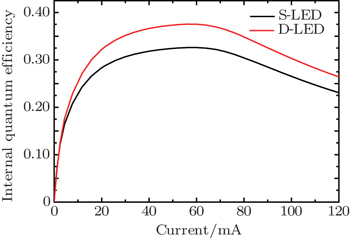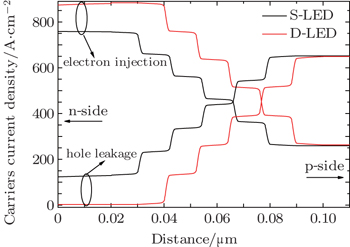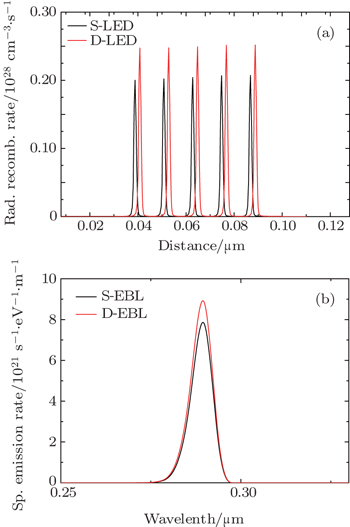† Corresponding author. E-mail:
Project supported by the Special Strategic Emerging Industries of Guangdong Province, China (Grant No. 2012A080304006), the Major Scientific and Technological Projects of Zhongshan City, Guangdong Province, China (Grant No. 2014A2FC204), and the Forefront of Technology Innovation and Key Technology Projects of Guangdong Province, China (Grant Nos. 2014B010121001 and 2014B010119004).
The AlGaN-based deep ultraviolet light-emitting diodes (LED) with double electron blocking layers (d-EBLs) on both sides of the active region are investigated theoretically. They possess many excellent performances compared with the conventional structure with only a single electron blocking layer, such as a higher recombination rate, improved light output power and internal quantum efficiency (IQE). The reasons can be concluded as follows. On the one hand, the weakened electrostatic field within the quantum wells (QWs) enhances the electron–hole spatial overlap in QWs, and therefore increases the probability of radioactive recombination. On the other hand, the added n-AlGaN layer can not only prevent holes from overflowing into the n-side region but also act as another electron source, providing more electrons.
Over the past decades, plenty of studies have focused on the performance optimizations of laser diodes (LDs) and visible high-brightness light-emitting diodes (LEDs) theoretically and experimentally,[1–3] especially the organic LEDs,[4,5] and GaN-based blue LEDs,[6,7] and very recently some new achievements have also be reported in this field.[8–11] In order to enhance the internal quantum efficiency (IQE) as well as reduce efficiency droop, many researches focus on improving light output power and increasing radioactive recombination by increasing hole injection, strengthening carrier confinement in the quantum wells (QWs), alleviating electron leakage and weakening polarization electrostatic field in the active region.[12,13] All of those efforts lead to entering the mature period of visible light emission device technologies. Therefore, a new field-invisible light optoelectronic device with a shorter wavelength, known as an ultraviolet light-emitting diode (UV-LED), has gained researchers’ close attention. The reasons can be attributed to their extensive roles in science research and daily life, such as chemical sensors, medical applications, water sterilization, full-color displays, etc.[14–16]
Despite the attractive prospect, there are also several challenges to the AlGaN-based UV-LED, such as poor hole injection efficiency and electron leakage from multi-quantum wells (MQWs) into the p-type layers, which leads to low carrier concentrations in active layers and weak radioactive recombination.[17,18] In recent years, various approaches have been put forward to cope with those challenges. Such as replacing conventional electron blocking layer (EBL) with multi-quantum-barrier EBL[19] to improve the electron injection efficiency, adapting composition-varying AlGaN multilayer barriers in the multiple quantum wells (MQWs)[20] to improve the performance of AlGaN-based UV-LED, and using a p-GaN micro-rod technique to improve the light output power of near-UV InGaN/AlGaN LED.[21] The reasons can be explained as follows. The markedly reduced polarization-induced electrostatic field within QWs suppresses the electron leakage and increases the hole injection efficiency; as a result, more electrons can recombine with holes. Wu et al.[22] reported that the hole injection efficiency of AlGaN-based deep UV-LEDs can be enhanced markedly when a single step quantum well is adapted to the EBL, resulting from the alleviated band bending near the special EBL. Zhang et al. have proposed that a p-AlGaN inserted layer with lower Al composition than that of the last barrier between the EBL and active region in AlGaN-based UV-LEDs can also enhance hole injection and lower the electron leakage tremendously.[23] On the other hand, some suggestions about designing the EBL have also been reported, such as AlGaN-based deep UV-LED with Al content-graded AlGaN EBL,[24] near–UV LED with InAlN/GaN superlattice EBL,[25] AlGaN/GaN superlattice EBL,[26] and adopting n-AlGaN EBL.[27] All of those methods reach a similar purpose of enhancing carrier inject efficiency, reducing electron leakage, and finally improving radioactive recombination, IQE, and output power. However, those complicated structures are hard to grow in practice.
Recently, a novel structure of blue GaN-based LED with double EBLs to mitigate the efficiency droop at a high current density was proposed.[28] What they adopted is p-AlGaN EBL and p-AlInGaN EBL with a p-GaN layer inserted between them near the p-side region. In addition, the simulations in Refs. [29] and [30] also indicate the advantage of the n-AlGaN EBL over the p-AlGaN EBL in GaN-based blue LED, and according to Ding et al., a specially designed n-AlGaN hole blocking layer is also beneficial to improving the performance of blue InGaN LED.[31] Inspired by their ideas, in this work, on the basis of a conventional UV-LED with a high Al component p-AlGaN EBL, we propose a novel structure, that is, AlGaN-based deep UV LEDs with double EBLs on both sides of the active region to enhance the hole and electron injection efficiency. Meanwhile, we make use of the crosslight advance physical model of the semiconductor device (APSYS) program to probe into the band diagram, and the optical and electrical properties of the structure. APSYS is a general purpose 2D/3D modeling software program for semiconductor devices. Based on the carrier transport equations, the Schrödinger equation, the current-continuity equation self-consistently and Poisson's equation,[32] it includes many advanced physical models such as hot carrier transport, hetero junction models, and thermal analysis. The basic physical models are described as follows:


The non-radiative recombination process contains the indirect recombination (Shockley–Read–Hall [SRH] recombination) and Auger recombination. The SRH recombination is given as

Auger recombination is given as

The carrier concentrations in the semiconductor device are described by the Fermi–Dirac distribution and parabolic state density:

The conventional structure UV-LED with a single p-AlGaN EBL in the p-side, denoted as S-LED, which is viewed as a reference, is shown in Fig.
As for the simulation parameters, we use the following formula[33] to calculate the band gap energies of AlGaN:

In order to demonstrate the outstanding properties of doubled EBL deep UV-LED, we investigate the light output powers and the internal quantum efficiencies of both structures mentioned above. The output powers each as a function of the current for S-LED and D-LED are plotted in Fig.
In order to shed light on the origin of the enhancement of the optical performance in detail, the contrastive electrostatic fields and calculated energy band diagrams of both S-LED and D-LED within the active region at 120 mA are shown in Figs.
 | Fig. 5. Energy band diagrams with ground-state electron and hole wave functions of (a) S-LED and (b) D-LED at 120 mA. |
As we can see evidently in Fig.
Figures
According to Fig.
Therefore, the carrier concentrations are certain to be enhanced in the active region for the D-LED. Figure
 | Fig. 6. Linear plots for (a) electron concentrations and (b) hole concentrations of two LEDs near the active region at 120 mA. |
The hole leakage for the S-LED is 129.2 A/cm2, while the hole leakage for the D-LED is almost zero. The electron injection in the first QW for the D-LED is 883.8 A/cm2, vastly larger than that for the S-LED, which is 757.1 A/cm2. Obviously, the radioactive recombination rate and spontaneous emission rate, plotted in Fig.
In this paper, the AlGaN-based DUV-LEDs with double EBLs inside the active region are investigated theoretically by using APSYS software. The simulation suggests that when both p-EBL and n-EBL are adopted, the polarization-induced electrostatic field within the QWs is mitigated, so does the electrostatic field between the n-side and the active region. As a result, the overlap between electron and hole wave functions is improved compared with the scenario of a conventional LED with a single p-EBL, the efficiency of the hole injected into the active region is increased and the carrier blocking effect is enhanced. Finally, the optical performances of the AlGaN LED with both the p-EBL and n-EBL at high current are optimized, and the larger recombination rate, a much higher light output power and IQE are obtained. We can expect that the double EBLs plays an important role in improving the performances of AlGaN-based DUV-LED. So, the technological process and grown conditions of this method are simpler than those of other complicated EBLs.
| 1 | |
| 2 | |
| 3 | |
| 4 | |
| 5 | |
| 6 | |
| 7 | |
| 8 | |
| 9 | |
| 10 | |
| 11 | |
| 12 | |
| 13 | |
| 14 | |
| 15 | |
| 16 | |
| 17 | |
| 18 | |
| 19 | |
| 20 | |
| 21 | |
| 22 | |
| 23 | |
| 24 | |
| 25 | |
| 26 | |
| 27 | |
| 28 | |
| 29 | |
| 30 | |
| 31 | |
| 32 | |
| 33 | |
| 34 | |
| 35 |








